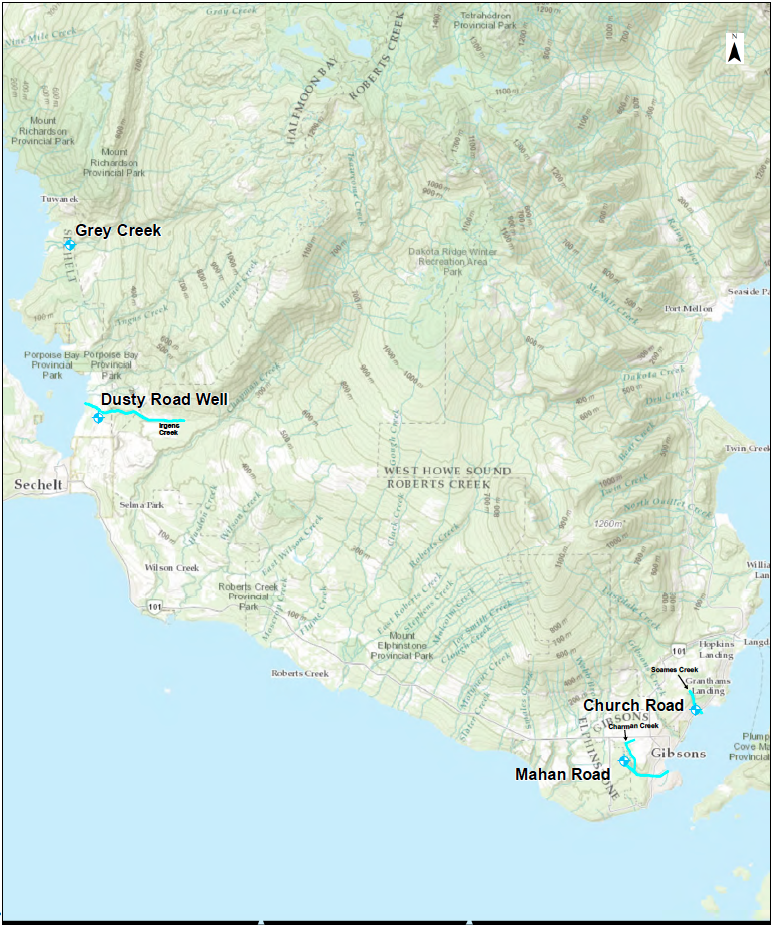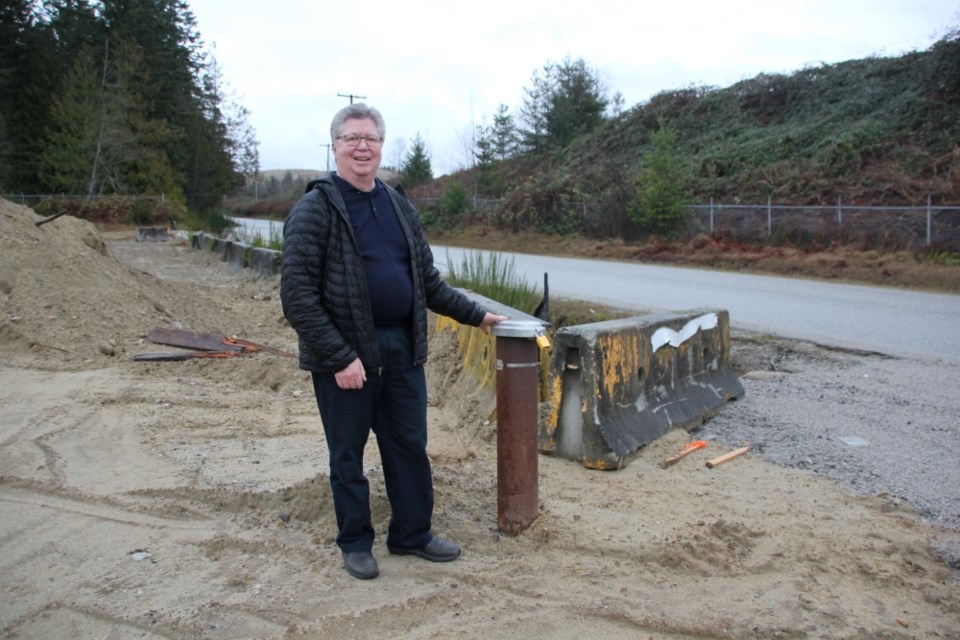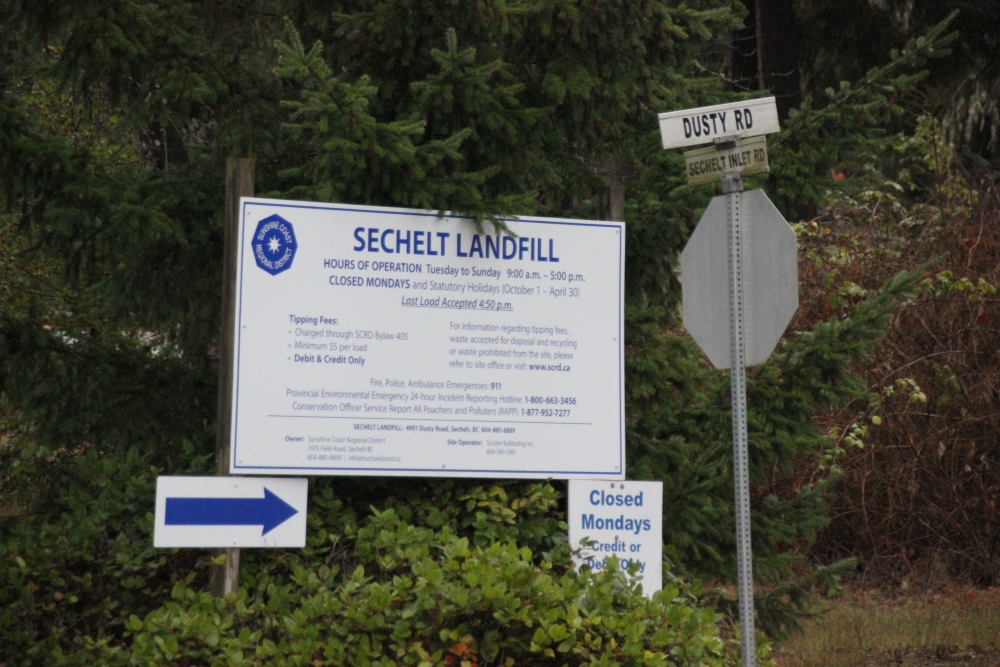The mayor of Sechelt is calling on local and provincial governments to find an immediate solution to the Sunshine Coast’s water crisis by drilling a well at Dusty Road in Sechelt — and he says it can be done within six months.
While the idea of a well at Dusty Road is not new, on Jan. 12, Mayor John Henderson published his “personal view of the actions” that need to be taken to meet immediate and future water needs. The document outlines Dusty Road in East Porpoise Bay as “affordable” and able to “produce significantly more volume of water than the Sunshine Coast Regional District (SCRD) hopes to get from the soon-to-be completed Church Road well near Grantham’s Landing.”
Henderson’s statement says he plans to present his ideas to the District of Sechelt council and the Sunshine Coast Regional District board in two weeks. While Henderson has yet to formally present his ideas to local governments, elected officials from shíshálh Nation, the SCRD, Town of Gibsons and District of Sechelt attended a water summit on Jan. 16.
In a Jan. 13 interview, Henderson told Coast Reporter, “There’s no denying that we need water” and that the Coast is in an emergency.
He acknowledged “there’s much better long-term solutions than Dusty Road … but we need water for the farmers this summer. Dusty Road has been studied. Inevitably, you could do more, but we don’t have the time.” He adds that the Coast needs water in the next six months, as well as the next two or three years before longer term solutions can be built.
“We need water now, not in three years.”
On the heels of a crisis
Although Henderson’s statement was published during a rainfall warning for the Sunshine Coast, it comes just a month after severe water restrictions were lifted after more than 100 days.
He notes the election in the fall of 2022 was “almost exclusively run on water” as one of the main issues. Two days after election day in B.C., the SCRD, District of Sechelt and shíshálh Nation declared states of local emergency due to drought.
When Henderson took his oath of office as mayor on Nov. 2, he said in his inaugural address that “the easiest and fastest solution is to drill a well on the District of Sechelt land of Dusty Road.” The idea of drilling a well in Sechelt in 2023 was also featured in his election campaign materials.

A brief look at Dusty Road
Dusty Road was one of several sites the SCRD had analyzed in the Groundwater Investigation Phase 2 Project report in its search for new groundwater wells to expand the Chapman water system. In a presentation to the SCRD board in January 2019, the recommendation was to abandon consideration of Dusty Road, since there were other options the SCRD could pursue at the time that were not surrounded by industrial use.
The report showed a test well drilled at Dusty Road in 2018 found the potential for a substantial yield of 64 litres per second. The same report found a sustainable pumping rate with BC safety factor of 30 per cent for Church Road to be 25.7 litres per second.
In Nov. 2019, the SCRD board asked staff to conduct a feasibility report regarding Dusty Road. shíshálh Nation and Lehigh confirmed plans to log and quarry an upslope lot in the coming decades.
But as mentioned in several SCRD meetings in the years following that presentation, SCRD staff have outlined several concerns with the feasibility of Dusty Road: a potential for contamination based on proximity to the gravel mine and the landfill, overlapping jurisdictions, and future industrial interests in the area. The new Sechelt Public Works building is now under construction next to the test well.
Unlike Church Road, Dusty Road is considered to have an unconfined aquifer. The 2019 report notes “Unconfined aquifers do not have this overlying layer of less permeable material and are therefore more susceptible to contamination from the surface” such as from spills or leaks from oil/gas machines. It gave Dusty Road the lowest score despite having the highest calculated sustainable yield, compared to test sites at Church Road, Mahan Road and Gray Creek.
From that January 2019 report and subsequent meetings, a recommendation was made to pursue Church Road as a well site. The water licence for Church Road was prioritized by the province, and took two years to receive approval (the SCRD applied for a water licence in 2019 and it was granted in December 2021). Since then, the Church Road project has faced global supply change issues and was estimated in October 2022 to cost up to $9.27 million. It has yet to come online, but is expected to add five million litres of water per day to the Chapman water system.
During a Nov. 16 meeting between the SCRD and local businesses about water, SCRD’s general manager of infrastructure services Remko Rosenboom was asked about the Dusty Road site. He said the SCRD board decided not to pursue that source as it was not “a long term, cost efficient development.” He also noted a well in that location would pull water from Chapman watershed.
“Ultimately, from community water supply perspective, you're not gaining anything because you're just taking it from a different location,” Rosenboom said at that meeting.
Now, Henderson’s statement asks “What are we waiting for?” before stating that the SCRD’s choice not to proceed with Dusty Road was based on reasons that he “and many experts, feel are flawed” such as not drilling the test well deeper. He writes that concerns for contamination risks and potential future industrial developments are “miniscule and entirely manageable.” A well at Dusty Road could be “simply shut down” if it were impacted by developments in future years.
The mayor sees Chapman Lake as the best reservoir the Coast currently has. He told Coast Reporter that the more water that can be drawn by Church Road and Dusty Road wells, the more water is reserved in Chapman Lake for later in the season.
Ministry approvals
When asked about the six-month timeline he’s put forward, Henderson said, “Of course, it’s ambitious, but it’s an emergency.” He couldn’t speak to supply chain issues, but said for approvals he intends to go to Victoria in the next two or three weeks to meet with the minister responsible for water. “My message to him will be we haven’t got time to wait for this process.”
A meeting with that minister had not been scheduled as of Jan. 13. Henderson said he’s provided the MLA, Nicholas Simons, with a copy of his Dusty Road document.
In a Jan. 17 email to Coast Reporter, a spokesperson for the Ministry of Forests (formerly known as the Ministry of Forests, Lands and Natural Resource Operations and Rural Development or FLNRORD) said there have been no detailed discussions between the Water Authorizations Team and the SCRD about the regional district’s groundwater exploration project, although the province is “aware of the SCRD’s exploratory drilling in the area at a few different locations.”
“For a large municipal water supply system, the planning process takes several years,” the ministry said, and the municipality would require: an environmental assessment certificate or approval through the Environmental Assessment Office’s project notification process; a Drinking Water Protect Act operating permit from the local health authority (Vancouver Coastal Health); a water licence from the Ministry of Forests; and any other permits or land use tenures.
When asked about conversations with shíshálh Nation Henderson said they also need water. He pointed to existing wells at the Nation’s Lehigh mine site that could potentially be an option for further supply. In a press release about the Jan. 16 water summit between Coast governments, hiwus Warren Paull said, “We need to meet challenges associated with our water supply head on and ensure that this vital resource is protected for our communities and future generations.”
On the risks
“It is a short-term solution and we can manage the risks,” Henderson said of Dusty Road. “I respect that there's an effort to always eliminate risk, of course… In this case, I'm saying the risk of not having water is much greater than the risk of using a little bit of what might be taken from the bigger aquifer.”
He suggests that if Dusty Road were drilled deeper, “there's a strong degree of evidence that we could get into a confined reservoir, confined aquifer. If we do, that is akin to Gibsons’s water.”
In the document Henderson published, it states, “We don’t need studies, we don’t need surveys, we don’t need approvals. We need water and we need it now.” When asked what he means by this, Henderson said, “In an emergency, you don’t wait for every i to be dotted and t to be crossed. We are not going to put the public at risk. We’ll deal with it in ways that are effective, that maybe are not kind of the status quo.”
Another option that has been discussed previously is Gray Creek. Henderson said he is suggesting Dusty Road because it’s closer to the existing system.
“If we get water for the next five, 10, 20 years, that's a good investment because we need it,” Henderson said.
How much will this cost — and who will pay?
Henderson did not provide a specific cost for such a project. He said it will cost much less than Church Road, because it’s close to existing infrastructure. According to Henderson’s vision, water from Dusty Road would add to the SCRD’s larger water system.
At an October 2021 SCRD committee meeting, staff said development costs for Dusty Road were previously estimated at about $2 million but a new estimate would be required.
When asked who would be paying for a Dusty Road project, the District Sechelt or the SCRD, Henderson said, “None of this is about anybody trying to take over” rather that he is trying to highlight a solution. His goal, he said, is that the SCRD would end up being responsible, “but it’s an emergency. I’ve got to fight the house fire, I’m not waiting for the fire chief to show up — I’ll get the hose and start fighting the fire myself.”
What about a long-term solution?
Henderson also offers several suggestions for a long-term solution, but his main idea is to create a Water Supply Solutions Team made up of elected officials, government staff and experts. His statement says Henderson believes “it is reasonable for the team to complete this work in the first half of this year, then give industry the second half of the year to respond. This means we could be in a position to assess and select the best solutions before the end of 2023!”
The mayor also asking for people to come forward with their own ideas.
“It's easy to criticize something. But I don't actually want the criticisms without a solution. So if you're going to criticize this won't work, well tell me what will because, fundamentally, I am committed to getting the water we need.”
Henderson can be contacted at [email protected].
With files from Connie Jordison





